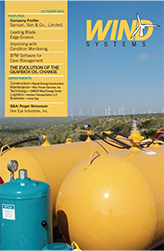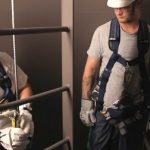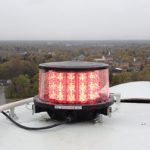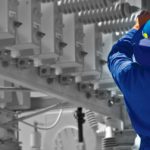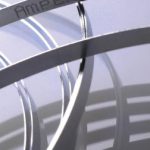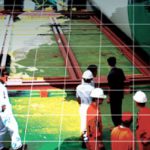Power plant operation is a bottom line driven business. Once an asset is built and providing power, every dollar spent on operation and maintenance affects that bottom line. Improvements to the plant reliability and performance can be made, but only with sufficent cost justitifcation to demonstrate return on investment. For condition monitoring (CMS), one factor is the known reliability of the particular wind farm, for example, take three onshore wind farms with MW class turbines with three point mounted drivetrain turbines with double spherical roller main bearings (DSRB). This type of turbine arrangement is known to have its issues, with failure of the downwind raceways and rollers. In this article we use a case study using site data to examine the bottom line. First from Weibull curves (a well known reliability analysis method) from several United States wind farms we have the data in Table 1. Note that main bearing failures are dependent on site conditions, bearing type, maintenance practices, etc. – this data is for problematic sites.
From these three farms we can construct a typical US wind farm with this issue for studying costs. The farm has 80 turbines, the size of turbine is approximately. 2MW and over ten years the average number of main bearing failures per year is 2.91 (based on the average data from Table 1), PPA is $55/MWhr, capacity factor is 0.35 and availability sits at 97% (excluding downtime from any main bearing failure). Each wind turbine brings $900 per day in revenue.
A question for the asset manager is: will condition monitoring improve the bottom line for main bearing issues on this wind farm? We paint a few scenarios in Table 2. First compare Scenario A and B, both with no condition monitoring, in each case the bearing fails and little warning was received. Only when the bearing availability is scarce (Scenario B), with three months lead time for repair, is the downtime a significant part of the cost. The cost is largely driven by crane mobilization and repair or replacement costs (costs quoted are typical but vary from site to site and are based on a refurbished bearing). Compare to Scenario C, the CMS system gives early warning of the failure, yet there are still separate crane mobilizations. Savings thanks to CMS are in the order of $40K where bearings are readily available and up to $300K when a lot of downtime is prevented (Scenario C versus A and B). More savings made when maintenance is scheduled more effectively due to the CMS (Scenario D). Given the early warning on the bearings (and it takes months for the DSRB failure mode to progress) repairs for the two failures are now scheduled for the same week, the crane is only mobilized once and savings are now in the order of $150-400K, depending on downtime saved (Scenario D versus A and B). Here the CMS system has added value with payback for retrofit installation and monitoring over three to four years, without considering potential benefits to the gearbox and generator. For different turbines and sites costs vary and where a known reliability issue exists, ROI calculations for CMS systems can be completed to evaluate benefits.
With the slow rotation it is often said that a damaged main bearing is difficult to detect with vibration; this is true where a standard envelope spectra or vibration RMS may not discern the damage from other vibration sources. However with the right techniques the condition monitoring is very effective for the main bearing and the progression of damage can be monitored over three to six months while the bearing deteriorates, finally when the temperature rises the bearing condition is very poor and replacement within a few weeks is recommended. Figure 1 provides an example where a low frequency accelerometer recorded time series data which was then processed in the Romax InSight iDS software for early detection of main bearing failure. This typical example illustrates how no special hardware is needed for main bearings, just good signal processing. By point D in the diagram the condition of the bearings is very poor, typical to a set (Figure 2) inspected in a factory teardown.
SCADA Monitoring
Aside from condition monitoring (via accelerometers, oil particle counters and so on) the turbine SCADA system is a valuable source of data for monitoring the turbine. From the 100’s of channels of data coming in (typically at a 10s sample rate) there are sets of parameters useful for checking the health of machine and also the performance. In many cases they are related, e.g. a high yaw misalignment will reduce performance, but also effect the health of the turbine longer term, as the rotor bending moments are increased and accelerate structural fatigue for all major components in the load path: pitch bearing, rotor hub, main bearing, main shaft, main frame, yaw bearing and depending on the drivetrain architecture also the gearbox. Analyzing SCADA data together with the maintenance records is also an effective way for the wind farm operator to monitor and control the maintenance quality.
|
Using SCADA and CMS Data to Improve End of Warranty Many end of warranty inspection RFP’s are written with a SCADA and vibration analysis component to the scope of work. A sensible choice if the data is available, but generally the work is timed to coincide with the uptower inspections. Then the effort to identify faults in the turbine is less worthwhile. An improved RFP would separate the workscopes, the SCADA and vibration analysis should take place one to two months before the inspections and help lead the inspecting technicians to find evidence of particular faults. Take a bearing axial crack an intermediate shaft for example, this can be a difficult bearing to inspect, with only a small portion of the bearing visible and many borescope inspections won’t find these cracks. A vibration report indicating where damage is expected will aid the technican in planning better the two to four hours they have allocated for each machine looking for damage in the gearbox. From the SCADA system Romax takes a data dump of pitch and yaw positions, component temperatures, pressures and currents, wind speeds, power, alarms and various other parameters and using the InSight SCADA software perform an exhaustive search of each and eve ry problem that is identifiable from SCADA. Where there is a CMS system installed a data dump to Insight iDS allows for thorough assessment of the condition of the main bearing, gearbox and generator. Using portable CMS is another option and this can be cost effective if the measurements are made during regular maintenance in the lead up to the EOW inspection. |
Figure 3 shows a bearing temperature histogram from a European offshore wind farm analyzed in the Romax InSight SCADA software. After replacement of the high speed shaft bearing, the temperature histogram for the following months shifted to a higher temperature range with maximums up to 85°C. Unfortunately, this temperature shift was not identified at that time. As a result, the bearing had been running under this unhealthy condition and failed the gearbox within 12 months. Due to access and availability issues offshore, the gearbox wasn’t replaced until seven months later and the cost of downtime and repair was in excess of $1M.
Figure 4 provides the SCADA alarm history for another offshore wind farm. Here Turbine 78 has a large number of generator bearing temperature alarms and shutdowns. The total downtime for this machine from this one fault accumulated to 780 hours (an 8.9% availability reduction) over 12 months. This many production hours is around $75k at the site but as the alarms were more regular during high wind speeds, the real production loss was nearly $150k. In order to reduce the downtime, a reactive generator bearing replacement was carried out in September. However, the high temperature alarms continued. Another generator bearing replacement program was carried out two months later. The alarm problem still wasn’t solved after the second bearing exchange program, and with the issue prevalent on other machines at the site, an investigation was carried out by Romax to solve the problem. The replaced bearings were examined and a root cause analysis was conducted. This RCA determined the alarm wasn’t triggered by faulty bearings, but due to other factors. The misdiagnosis not only caused production loss, but also incurred unnecessary maintenance cost, with totals nearing $500k. Romax InSight SCADA brings together maintenance records, inspection reports and analysis reports with SCADA data to provide a powerful tool for assessing the site. This allows for a clear visualization (Insight) so the site manager or control center operators can easily see such correlations and make more informed decisions in operations and maintenance. Figure 5
|
InsightTM powered by TCM® Earlier this year two leading specialists in wind turbine condition monitoring and health management joined forces, providing wind asset owners and operators with exemplary solutions combining world class hardware, software and monitoring services. A strategic alliance was forged between Gram & Juhl (http://gramjuhl.com), providers of the world leading TCM® turbine condition monitoring system and Romax Technology the industry leader in gearbox and drivetrain monitoring and design. The alliance offers customers Romax’s highly innovative InSight iDS (Intelligent Diagnostic System) as a configurable interface for TCM,® with expert monitoring services worldwide. InSight iDS comprises powerful front-end software, providing an intuitive and user-friendly dashboard. The alliance provides customers with ‘the best of all worlds’ bringing together best in class hardware, software and monitoring services. The combined offering significantly enhances customers’ understanding of the current and future condition of their wind assets, enabling them to implement a highly effective predictive maintenance regime, resulting in significant improvements in yield, availability and profitability. Axel Juhl, CEO of Gram & Juhl, said “We are excited by the prospect of developing this complementary relationship with Romax, as it enables Gram & Juhl to strengthen our position as the leading provider of condition monitoring systems and to provide an exceptionally high level of local support and monitoring service to TCM® users, globally.” Gram & Juhl is one of the most experienced providers of turbine condition monitoring solutions and have installed over 5500 TCM® systems worldwide since 1997. Romax Technology is a global engineering consultancy offering technical solutions for O&M, advanced design services and software tools. Their field service portfolio includes end-of-warranty assessment, failure analysis, drivetrain health monitoring and strategic review; as well as concept design, analysis and modelling, detail design, design review and certification. |



















